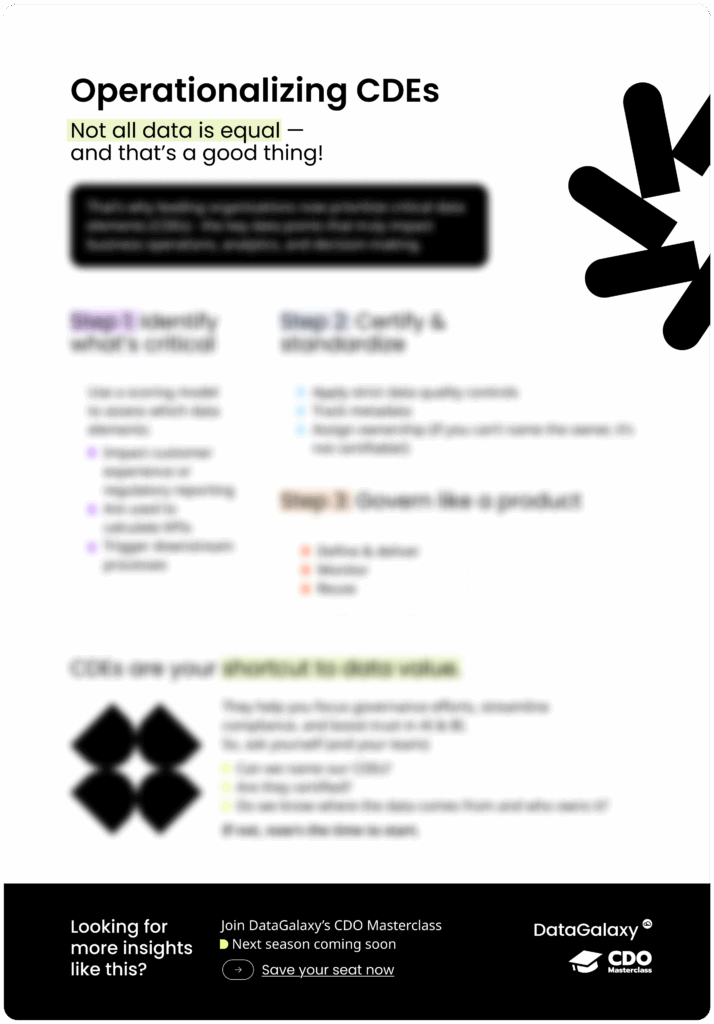
How to align your data strategy with business outcomes in 3 easy steps
Data strategy can no longer exist in isolation.
No matter how sophisticated the tools or powerful the datasets, a data strategy untethered to business priorities risks irrelevance or worse – wasted investment.
The pressure is rising. Reporting on infrastructure and dashboards isn’t enough. Boards and executives demand data strategies that directly impact growth, efficiency, and risk reduction.
To meet this mandate, CDOs and data leaders are evolving their strategies, moving beyond technical excellence to align data projects with business outcomes. However, alignment is not about choosing one-off projects; it’s about building a strategic foundation that enables every initiative to move the enterprise forward.
How are they achieving this?
TL;DR summary
Data strategy can no longer operate as a siloed technical function. Today’s organizations expect their Chief Data Officers (CDOs) and data leaders to directly influence growth, efficiency, and risk reduction.
Business alignment ensures data initiatives are intentionally tied to the enterprise’s highest-impact objectives—not just dashboards or pipelines. By grounding data strategy in business goals, translating strategy into use cases, and prioritizing by strategic value, organizations transform data from a cost center into a value-generating engine.
Modern platforms like DataGalaxy make this alignment scalable by enabling end-to-end data & AI product governance.
What is data strategy business alignment?
Data strategy business alignment means that every data initiative—every dashboard, model, and platform—exists to move the enterprise toward its most critical business outcomes.
In theory, it sounds straightforward. But in practice, it requires a deliberate shift pivoting away from managing data as an internal asset to activating it as a business accelerator.
For years, data teams operated behind the scenes—optimizing pipelines, maintaining infrastructure, and building dashboards. Those fundamentals still matter, but they are no longer enough. Executives now expect data strategy to be:
- A growth accelerator
- A risk-reduction mechanism
- A driver of operational efficiency
- A decision intelligence engine
Without a tight connection to business priorities, even the best technical solutions risk low adoption, stalled momentum, or wasted investment.
Modern data leaders are evolving their role from data custodians to strategic partners—moving from building data assets to orchestrating enterprise-wide value creation.
The business benefits of data strategy alignment
High-performing organizations increasingly treat data alignment as a core organizational capability. The benefits compound across the enterprise:
The benefits of this shift can include:
- Sharper decision-making: Grounding data initiatives in business priorities gives leaders faster access to the right insights to steer high-impact decisions
- Targeted impact: Strategic alignment focuses time, talent, and investment on the highest-value opportunities
- Cross-functional collaboration: Shared priorities pull business and data teams into tighter alignment, turning insights into action and accelerating real business outcomes
- Enterprise agility: When strategy and data move together, organizations can more quickly adapt to shifting priorities without losing momentum or focus
Together, these capabilities elevate data from a tactical resource to a strategic differentiator.
How to align your data strategy with business outcomes in 3 easy steps
Step 1: Ground data projects in business goals
Data cannot create value in isolation. Value emerges only when data strategy is intentionally linked to the business’s core priorities—growth, efficiency, innovation, and competitive advantage.
High-performing data teams use structured, repeatable mechanisms to enforce alignment.
Business/data alignment frameworks
Standardize the intake process so no project moves forward without:
- A documented connection to business objectives or OKRs
- Clear expected outcomes
- Defined business stakeholders
This creates a consistent “gateway” to ensure every project aligns with the enterprise strategy.
Embedded data stewardship
Position data team members within business units. Proximity fosters:
- Better operational understanding
- Faster iteration
- Tighter alignment between use cases and real-world needs
Strategy calibration sessions
Business priorities evolve.
If data teams don’t evolve alongside them, misalignment compounds over time. Quarterly calibration keeps data strategy current and relevant.
Data literacy & accountability
Enterprise-wide data literacy ensures business teams can:
- Interpret insights
- Own KPIs
- Partner effectively with data teams
This shifts data from a specialist function to an enterprise-wide capability.
Pro tip: Adopt the Business Sponsor Rule: No data project moves forward without a committed executive sponsor. No sponsor = No project.
Operationalizing
CDEs
Do you know how to make critical data elements (CDEs) work for your teams?
Get your go-to guide to identifying and governing critical
data elements to accelerate data value.

Step 2: Translate strategy into targeted use cases
A strategy sets the direction. Use cases deliver the impact.
Data leaders translate broad business goals into precise, actionable initiatives by asking sharp, answerable questions.
Example transformations
| Business Goal | Strategic Question | Data Use Case |
|---|---|---|
| Expand market share | Which customer segments offer the highest growth potential? | Behavioral segmentation using purchase data + market trend analysis |
| Boost customer retention | Which customers are most at risk of churning? | Predictive churn modeling with behavioral and transactional inputs |
| Improve operational efficiency | Where are unseen bottlenecks impacting delivery? | Workflow mapping and cycle-time analytics across business units |
Align use cases with business KPIs
Use cases must be tied to metrics the business already tracks, such as:
- Customer Lifetime Value (CLV)
- Revenue growth
- Cost-per-acquisition
- Cycle time improvement
- Retention rates
Technical metrics (e.g., pipeline throughput, dashboard views) support engineering—but they don’t demonstrate business impact.
Tell business-driven stories, not data stories
Effective data leaders communicate results using narratives that show:
- The business context
- The insight generated
- The action taken
- The measurable impact
Narrative reinforces the strategic role of data and makes insights actionable at the executive level.
Make audits easy with built-in traceability
Every action is tracked.
Track object actions, user activity, and stewardship changes in one place. With DataGalaxy, nothing goes unnoticed, so you’re always ready for audits and accountability.
Discover DataGalaxyStep 3: Prioritize projects by strategic value
Ideas are infinite. Resources are not.
Great data leaders prioritize initiatives that drive the strongest alignment between business outcomes and technical feasibility.
How to prioritize for strategic value
1. Start with business impact: Which initiatives directly advance top enterprise goals—growth, efficiency, risk reduction?
2. Require business sponsorship: If there is no accountable business owner, the initiative is not strategically relevant.
3. Use a Value vs. Complexity Matrix: Identify quick wins, long-term bets, and discard low-value, high-effort initiatives.
4. Integrate metrics into enterprise dashboards: If leadership cannot see the initiative’s impact in their existing reporting structures, alignment will fade.
Pro tip: Use a visual scorecard linking data KPIs → business KPIs → enterprise OKRs. This builds trust and demonstrates strategic contribution.
5. Kill or pivot quickly: If an initiative stalls or loses business relevance, pivot or eliminate it. Alignment requires continuous focus.
Common mistakes that break alignment
Even strong data strategies falter when these pitfalls appear:
Leading with technology instead of impact
Tools should support strategy, not drive it.
Losing stakeholder engagement
Without continuous communication, projects drift away from business needs.
Measuring activity instead of impact
Dashboards delivered ≠ value created. Impact = business outcomes achieved.
Skipping business ownership
Projects without sponsors rarely influence strategic results.
Avoiding these pitfalls preserves momentum and ensures data strategy remains enterprise-critical.
How to keep data strategy aligned with business outcomes
To ensure long-term alignment, data leaders must:
- Anchor all initiatives in business goals
- Translate strategy into precise use cases
- Prioritize by strategic impact and feasibility
- Ensure continuous stakeholder ownership
- Create visible, measurable links between data work and enterprise results
When this loop is executed consistently, data isn’t a support function—it becomes:
- A growth engine
- A risk buffer
- A competitive differentiator
This is the difference between technical wins and strategic enterprise transformation.
Designing data & AI products that deliver business value
To truly derive value from AI, it’s not enough to just have the technology.
- Clear strategy
- Reasonable rules for managing data
- Focus on building useful data products

How does DataGalaxy support data strategy business alignment?
As a Data & AI Product Governance Platform, DataGalaxy enables organizations to operationalize alignment through:
- A centralized data catalog
- Business-friendly metadata management
- Automated data lineage
- Clear data ownership and stewardship
- Use case documentation that links data assets to business outcomes
- Governance workflows tied to enterprise objectives
- Cross-functional data literacy enablement
DataGalaxy turns data strategy from conceptual to operational—ensuring alignment, accountability, and value realization.
How to align data projects with business outcomes
Ground data initiatives in business goals, sharpen strategy into actionable questions, and prioritize by business impact.
This approach forms a closed loop that keeps data work locked onto what matters most.
When data leaders align data projects with business outcomes, it’s no longer a support function. It becomes a catalyst for growth, a shield against risk, and a foundation for achieving high-impact results across the enterprise.
Data strategy business alignment is the difference between producing technical wins and delivering outcomes that move the business forward.
FAQ
- Can DataGalaxy adapt to my organization’s data landscape?
-
Yes. DataGalaxy is built to support hybrid, multi-cloud, and evolving ecosystems. Whether you’re wrangling spreadsheets, Snowflake, or SaaS tools, the platform connects and documents everything — while staying flexible enough to reflect your teams’ real-life workflows, business terms, and governance needs.
- Can a data catalog scale with my team as we grow?
-
Absolutely. A robust catalog supports multi-domain growth, role-based access, and metadata from an expanding tech stack. DataGalaxy is designed to grow with your needs — across teams, geographies, and governance maturity.
- How does DataGalaxy create value for the business?
-
By turning data into a searchable, shared knowledge base, DataGalaxy helps teams spend less time chasing answers — and more time delivering impact. It improves data discoverability, reduces duplication, and accelerates decision-making. And with built-in governance, you reduce risk while increasing trust in every report, model, and initiative.
- How is value governance different than data governance?
-
Value governance focuses on maximizing business outcomes from data initiatives, ensuring investments align with strategic goals and deliver ROI. Data governance, on the other hand, centers on managing data quality, security, and compliance. While data governance builds trusted data foundations, value governance ensures those efforts translate into measurable business impact.
- Struggling to connect your data initiatives to business value?
-
You’re not just doing data. You’re building a data-driven business.
That means having a clear strategy, aligned teams, and measurable outcomes across your Data and AI initiatives.
But too often, data investments become disconnected from value — or from each other.
DataGalaxy gives leadership a unified view of assets, ownership, impact, and alignment. It’s where governance, analytics, and AI converge into one strategy.Facing this challenge? Explore the solution
Want to see it live? Book a tailored demo
Key takeaways
- Data strategy must be anchored to enterprise objectives—not technical activity.
- Use cases are the bridge between strategy and execution.
- Prioritization requires business sponsorship, measurable KPIs, and ongoing review.
- Avoid common pitfalls like tech-first thinking or KPI misalignment.
- With DataGalaxy, alignment becomes a scalable, repeatable governance capability.

